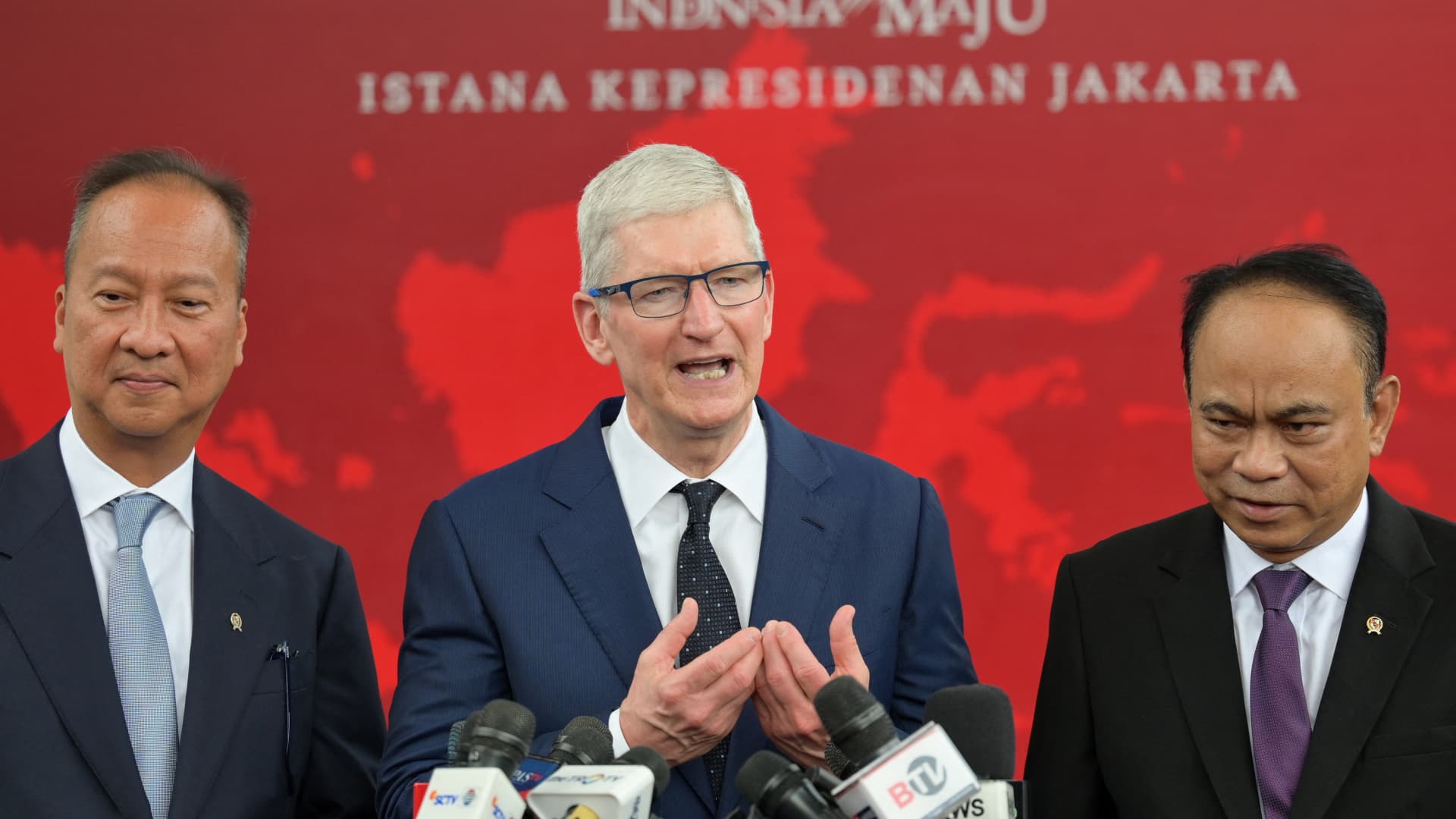Apple CEO Tim Cook (center) speaking alongside Indonesian Minister of Communication and Information Budi Arie Setiadi (right) and Indonesian Minister of Industry Agus Gumiwang Kartasasmita during a press conference after meeting with Indonesia’s President Joko Widodo at the Merdeka Palace in Jakarta on April 17, 2024.
Bay Ismoyo | Afp | Getty Images
Indonesia’s efforts to attract capital from Apple and other tech companies through local investment and manufacturing requirements are not enough to yield long-term gains and may backfire, economists warn.
Because of Indonesia’s long-standing local content policies, or “TKDN,” Apple has been unable to sell its latest iPhone model in the country until it invests or sources more components locally.
On Dec. 3, Indonesia’s deputy industry minister told reporters that the country plans to increase the local content requirement for smartphone investments.
The plans come after the government turned down a $100 million Apple proposal aimed at paving the way for iPhone 16 sales. Instead, the government is now asking Apple to invest $1 billion in cell phone component production in the country.
The content requirements, which apply to various industries ranging from solar panels to electric vehicles, aim to protect local industries and create a value-added supply chain in Indonesia.
Their potential ramp-up comes at a time when Indonesia is competing with other developing Southeast Asian countries, such as Vietnam, to attract investment and supply chains diverted from China.
However, although the content policy has attracted commitments from some manufacturers in the past, economists say it is still misguided and ignores many of the deeper reasons Indonesia has failed to entice tech supply chains.
“I call it pseudo-protectionism. It’s less about protecting the domestic market from imported products and more about trying to scare foreign direct investment into the country,” said Bhima Yudhistira Adhinegara, executive director of the Center of Economic and Law Studies (CELIOS), an Indonesian think tank.
“They think if they scare big corporations like Apple, they will invest more into Indonesia,” he added.
What’s at stake?
An Apple analyst previously told CNBC that Indonesia would be a promising growth opportunity for the Cupertino-based company if it is able to get a foothold in the market.
Until recently, Apple had won goodwill in the market by building “Apple Developer Academies” in the country, where students are trained in skills such as software development.
During a visit to Indonesia in April, Apple CEO Tim Cook announced that the company would open a fourth academy in Bali.
However, the government is now seeking more of Apple’s supply chain and wants more facilities involved in the actual manufacturing of products.
Officials have also said that the value of Apple’s previously proposed investments is lower than that of its Indonesian sales, arguing that smartphone companies like China’s Xiaomi and South Korea’s Samsung have invested more.
On Indonesia’s side of the bargaining table, it has the largest consumer base in Southeast Asia and the fourth-largest population in the world.
Still, Indonesia is a small overseas sales market for Apple, with few consumers wealthy enough to buy a cutting-edge iPhone, economists said. The company’s market capitalization alone is bigger than Indonesia’s gross domestic product.
On that note, Apple may be more interested in using Indonesia as a gateway to the regional market, said Arianto Patunru, board member at the Center for Indonesian Policy Studies.
He added that global tech supply chains such as Apple’s involve slicing up the value-added, so each country might only contribute a small amount.
Indonesia’s content policy requires 40% of smartphones and tablets to be locally made.
Will Indonesia’s ‘scare tactics’ backfire?
Most economists who spoke to CNBC said they did not believe that content policies would work to attract companies like Apple and would instead have the opposite effect.
“Local content requirements have not been successful in attracting FDI to Indonesia. Quite the contrary,” said Patunru, suggesting they contributed to companies like Foxconn‘s and Tesla‘s withdrawal of plans in the country in recent years.
Instead, Indonesia’s attempts to use “scare tactics” towards companies like Apple “may backfire,” according to CELIOS’ Adhinegara.
“I think it’s very bad for the investment climate in Indonesia and creates uncertainty on regulation,” Adhinegara said, noting that often regulations appear to be enforced on a case-to-case basis.
Yessi Vadila, a trade specialist at the Economic Research Institute for ASEAN and East Asia, said that local content requirements in Indonesia have historically been tied to increased costs, decreased export competitiveness, and productivity losses while offering little impact on growth or employment.
Other economists noted that the local content policies have racked up some surface-level successes in the past, though they said they would not be enough on their own to attract more investments from companies like Apple.
“I would say they have been successful in trying to build some factories and facilities,” said Indonesian economist Krisna Gupta, noting that other smartphone makers, such as Samsung, have had to invest in the market because of regulations.
In addition to its local content requirements, Indonesia has also implemented other protectionist policies, including tariffs, to drive greater investments into the country. Last year, a new law banned TikTok’s commerce app until the company invested through a local partner.
Holistic approach needed
Still, while Gupta said the strategy may find some success in the short to medium term, it will be met with problems in the longer run unless the government is also able to increase productivity and the overall business climate.
“Indonesia will need to step up their game across the board,” Gupta said, noting that companies consider a range of factors, including law enforcement, stability of trade policy, and the labor market.
“They can’t just say, we have a big market; you must want to be here, so please invest more,” he added.
To attract more FDI, the country must prioritize building competitive infrastructure, building human capital, and offering investment incentives, according to CELIOS’ Adhinegara.
Economists who spoke to CNBC pointed to Vietnam as a country that has managed to attract more tech investments despite not having as large of a local consumer market as Indonesia.
Instead of strict local content requirements, Vietnam has successfully leveraged investment incentives, consistent policies and strong infrastructure relative to its regional peers, they said.
The country has also has managed to set up a free trade agreement with Europe, whereas Indonesia is still trying to reach terms on a deal. Vietnam has also been one of the main beneficiaries of shifting supply chains from China amid growing U.S.-China trade tensions.
According to Adhinegara, Indonesia may soon be presented with a prime opportunity to attract diverted manufacturing, with Donald Trump set to return to the White House.
The president-elect has proposed massive escalations of tariffs on China, which could trigger another trade war and shake up Asian supply chains.
However, unless the Indonesian government understands why companies like Apple have chosen Vietnam over it in the past, they could miss out once again, said Adhinegara.
While Indonesia’s foreign direct investment has been growing over the years, its FDI as a share of GDP has only decreased over the past two decades, according to data from the World Bank.















